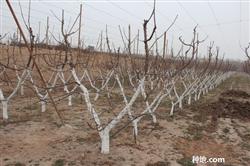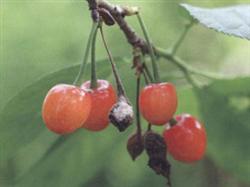What should we pay attention to in cherry cultivation?

What should we pay attention to in cherry cultivation? As the saying goes: cherries are delicious and trees are hard to plant. The difficulty of planting trees is mainly determined by the characteristics of cherry roots. The root system of cherry is very shallow, so it is afraid of drought; the root system has a higher respiratory intensity, has more oxygen than other fruit trees, and is most afraid of waterlogging. If the accumulation of water in the rainy season lasts a little longer, it will affect root respiration, with light yellow leaves and heavy ones dying. If you want to plant live and good cherries, you must do a good job in orchard establishment, planting and subsequent water management. First, the choice of garden. Select the land with high topography, not easy to accumulate water, low groundwater level, neutral or slightly acidic sandy loam with deep soil layer and good air permeability. If the soil quality is poor, soil improvement measures such as deep ploughing and organic fertilizer should be carried out before the construction of the garden, because cherries have high requirements for ecological conditions, deep living soil layer and strong soil fertility. only in this way can the cherry root system be developed, the tree potential be strong, the stress resistance be strong, and the fruit quality and yield are high. Especially the soil in the rhizosphere is difficult to improve after planting and establishing the garden. Second, irrigation and drainage design. There must be good irrigation and drainage facilities around the garden to ensure timely watering during drought and timely drainage and waterlogging prevention in the rainy season. For the new garden, the main ditch and branch ditch should be designed scientifically, and the plain or large plot of land had better be ridged and planted in order to make use of ridge and furrow irrigation and drainage. The infiltration to the root on the side of ridge and furrow irrigation can also avoid the consolidation of root soil after watering, which is beneficial to slow down the rooting of seedlings. Third, scientific planting 1, planting time: cherry planting is best in autumn, because of spring drought in the north, traditional spring planting increases the difficulty of water management. Moreover, if the spring planting is too early and the temperature is unstable, it is vulnerable to freezing damage; if it is planted too late in spring, it will sprout quickly and take root slowly, which will cause dead seedlings. Planted in autumn, it can slow down seedlings and sprout in the current season, and sprout early in the following spring, which is easy to form strong seedlings. After autumn planting, the soil should be buried to prevent frost before freezing. 2. Planting method: "small pit deep planting and shallow burying method" should be adopted. The traditional cultivation method of fruit trees dug a big hole is not suitable for cherries, because the cherry roots are shallow and not resistant to waterlogging, such as the cultivation of large pits, the soil in the pit is more pine than that around the pit, and it is easy to cause waterlogging in the rainy season, and dead seedlings will appear in serious cases. The "small pit deep planting and shallow burying method" means to dig out three or four shovels of soil, apply two shovels of soil fertilizer, mix the soil at the edge of the pit with the soil fertilizer in the pit, and then place the seedlings (select sturdy seedlings with well-developed roots), and cover a layer of shallow soil only to bury the original soil marks at the roots. Then the soil will be slightly compacted, so that the root neck is about 15 cm below the ground, forming a small tree nest under the seedling. In this way, "deep planting" reduces the center of gravity of seedlings and helps to resist lodging, while "shallow burying" is beneficial to root respiration, which makes seedlings slow, fast and grow well. 3. Water management. After planting, it should be watered frequently, but avoid flooding. Should be combined with the weather, drought is often watered, waterlogging is active drainage, to keep the rhizosphere soil surface dry and wet. Click to get more cherry planting techniques click to get more fruit planting techniques
- Prev

What to do if the cherry tree has brown rot?
What if the cherry tree has brown rot? How to control harmful symptoms cherry brown rot, also known as Sclerotinia sclerotiorum, gray rot and so on. It can damage flowers, leaves, branches and fruits, but the fruit suffers the most. After infecting the floral organ, the stamens and petals first appeared brown watery spots, then the whole flower rotted rapidly and the surface was covered with ash.
- Next

How to irrigate the cherry orchard
How to irrigate the cherry orchard? Cherry trees have shallow root distribution and high requirements for soil permeability. Compared with other deciduous fruit trees, they have large leaf area and transpiration, and a large amount of water in the fruit will be lost through the leaves when it is dry and hot. During the period of fruit development, soil drought will cause fruit drop; it is easy to experience rain or irrigation for a long time.
Related
- Moge, come on! The staff of the peasant association in the producing area of cantaloupe were frightened when the crowd gathered.
- Causes and Solutions of low Fruit setting rate of Apple
- Symptoms and control measures of passion fruit virus disease
- Fruit growing lesson: how do apple orchards keep high yields?
- Can you build orchards in the mountains? What are the pros and cons?
- How to manage the coloring period of Crisson grape?
- This paper introduces the processing technology of two kinds of fig products.
- How much is a month for retired teachers in rural areas by 2020?
- How can strawberry planting increase sugar content? We should pay attention to management in many aspects.
- What are the cultivation techniques on how to improve the yield of golden fruit?

